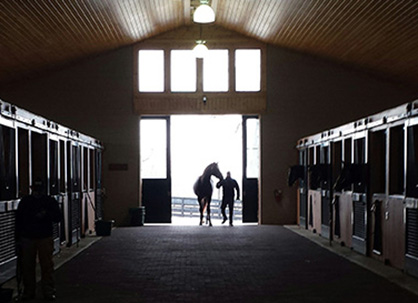How to Reopen Your Barn After Quarantine

Photo courtesy of Megan Arszman
American Horse Council (via ApHC)
The COVID-19 pandemic is responsible for a complete shift in the daily lifestyle of everyone in the United States, including our horses. Living under quarantine, curfews, and learning how to work from home has reiterated how important barn visits are to mental health. As states across the country relax stay-at-home requirements, we have some tips on how to keep your horses, horse people, and your barn as healthy as possible.
- Limit gatherings to as few people as possible, and continue to maintain the recommended social distancing protocols that include six (6) feet of separation between individuals. Just because the quarantine is being lifted doesn’t mean the threat is over. COVID-19 can be detected in the air for up to three hours after being transmitted. Some stables have created a schedule where clients can reserve time slots for their visits, reducing the amount of people in the barn by only allowing 3-4 people present at once. This may be the most appropriate step forward for those barns in states that were forced to close outright.
- Encourage proper hand-washing and provide as many locations/opportunities for people to do so. Due to the structure of the virus, washing hands with warm water and soap for at least 20 seconds is the most effective way to prevent contamination. Hand sanitizer must contain at least 60% alcohol to be effective.
- Make a daily or hourly cleaning chart to prevent virus transmission. Disinfect common contact areas regularly and avoid sharing equipment and supplies between people, COVID-19 can live on copper for up to four hours, cardboard for 24 hours, and plastic and stainless steel for up to 3 days.
- Non-porous materials (leather bridles/saddles/halters, nylon halters/lead ropes, gate latches, door handles, spray nozzle) harbor the virus longer than porous materials (cotton lead ropes, saddle pads)
- Clean communal leather tack daily with tack cleaner. Knowing how to properly disinfect tack is useful for any equestrian, be it for strangles or COVID-19. Aerosol sprays such as Lysol tend to strip leather of oils, so if you use an aerosol spray to disinfect your tack, be sure to let it dry completely and then recondition the leather to protect it.
- Soap and water is another effective way to break down the lining of bacteria and viruses and is often safe for most tack. Diluted bleach disinfects well, but leather may dry out and crack from repeated treatments.
- Disinfect gate latches, spray nozzles, cross tie snaps, pitchforks, wheelbarrows, and other frequently used items regularly or after contact with personnel.
- Stall door latches, hose ends, light switches, faucets and feed scoops should be cleaned and disinfected frequently.
- There may be state requirements to wear gloves or face coverings to reduce the risk of spreading germs. Many businesses will be looking to taking the temperature of those present in and will not allow anybody to come if they register a temperature or feel sick and this may go a long way to helping clients feel comfortable.
- Long story short, nobody spends two months on the couch unscathed, so take it easy getting back into training. Many riding stables are closed to tenants and all equine events have been canceled in an effort to reduce the virus’s spread. Due to these closures, many horses are not receiving regular workout schedules, or maybe no exercise at all. While daily lifestyles are difficult for all during this pandemic, adapting a horse’s schedule to a life after quarantine can be equally as challenging. Exercise related injuries would be a terrible way to end the quarantine.
Making boarders and clients safe and secure will be critical in getting the horse industry back on its feet, and each facility, whether private or public, should have written policies regarding COVID-19 and expect all clients and professionals to adhere to them. Keeping our horses healthy has always been a priority, but without their owners you can’t keep the lights on. All of these tips, and more, can be found on the AHC COVID-19 Resource Page, please visit it here.










